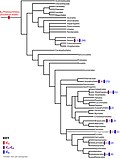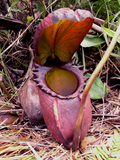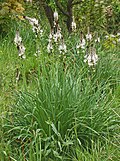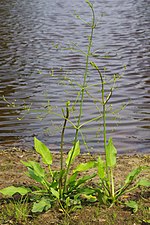The APG IV system of flowering plant classification is the fourth version of a modern, mostly molecular-based, system of plant taxonomy for flowering plants...
40 KB (2,558 words) - 13:57, 8 April 2024
Angiosperm Phylogeny Group (section APG IV (2016))
2016[update], three revisions have been published, in 2003 (APG II), in 2009 (APG III) and in 2016 (APG IV), each superseding the previous system. Thirteen researchers...
33 KB (3,527 words) - 05:32, 8 April 2024
Caryophyllales (section APG IV)
Petiveriaceae were added in APG IV. As circumscribed by the APG III system (2009), this order includes the same families as the APG II system (see below) plus...
12 KB (1,032 words) - 03:35, 8 April 2024
it was replaced by the improved APG II in 2003, APG III system in 2009 and APG IV system in 2016. The original APG system is unusual in being based,...
20 KB (1,426 words) - 19:08, 1 June 2024
APG system seeks to determine the number of families, mostly by molecular phylogenetics. In the 2009 APG III there were 415 families. The 2016 APG IV...
79 KB (6,219 words) - 20:10, 26 May 2024
Commelinids (section APG system)
walls containing ferulic acid. The commelinids are the only clade that the APG IV system has informally named within the monocots. The remaining monocots...
12 KB (837 words) - 03:56, 14 April 2024
Trimeniaceae (section APG IV)
in Southeast Asia, eastern Australia and on several Pacific Islands. The APG IV system, of 2016, recognizes this family and places it in order Austrobaileyales...
4 KB (440 words) - 02:50, 8 April 2024
group. The name "eudicots" (plural) is used in the APG systems (from APG system, of 1998, to APG IV system, of 2016) for classification of angiosperms...
15 KB (1,295 words) - 00:00, 25 March 2024
flowering plants: APG III", Botanical Journal of the Linnean Society, 161 (2): 105–121, doi:10.1111/j.1095-8339.2009.00996.x, hdl:10654/18083 APG IV 2016. Philip...
11 KB (1,176 words) - 06:19, 8 April 2024
Piperales (section APG system)
are mainly herbaceous plants possessing highly reduced flowers. In the APG IV system, of 2016, this order is placed in the clade magnoliids and is circumscribed...
5 KB (401 words) - 16:14, 5 June 2024
Dicotyledon (section APG vs. Cronquist)
Comparison of monocots and dicots The consensus phylogenetic tree used in the APG IV system shows that the group traditionally treated as the dicots is paraphyletic...
14 KB (782 words) - 01:10, 11 March 2024
the Angiosperm Phylogeny Group (APG). Published in 2009, it was superseded in 2016 by a further revision, the APG IV system. Along with the publication...
47 KB (3,194 words) - 04:17, 8 April 2024
Nepenthales (section APG IV system)
currently favor the APG IV system of 2016 over the older Cronquist system for classifying flowering plants (Angiosperms). The 2009 APG III system assigned...
3 KB (282 words) - 18:33, 6 May 2024
The Gunnerales are an order of flowering plants. In the APG III (2009) and APG IV systems (2016), the order contains two genera: Gunnera (family Gunneraceae)...
4 KB (415 words) - 03:01, 8 April 2024
circumscription has varied widely. In its current circumscription in the APG IV system, it includes about 40 genera and 900 known species. The type genus...
20 KB (1,417 words) - 05:52, 8 April 2024
addition of Sabiaceae, which the APG III system did not place in any order in the eudicots, would be sensible. The APG IV system of 2016 added family Sabiaceae...
6 KB (602 words) - 06:24, 22 April 2024
In the APG IV system (2016) for the classification of flowering plants, the name asterids denotes a clade (a monophyletic group). Asterids is the largest...
8 KB (649 words) - 03:37, 8 April 2024
flowering plants. The order did not exist in the 2009 APG III system, and was added in the 2016 APG IV system, including two families, Icacinaceae and Oncothecaceae...
2 KB (162 words) - 04:02, 8 April 2024
to place both families into an order. The order remains unchanged in the APG IV system. Under the Cronquist system, the Zygophyllaceae were included within...
5 KB (334 words) - 05:42, 8 April 2024
Ruppiaceae family Scheuchzeriaceae family Tofieldiaceae family Zosteraceae In APG IV (2016), it was decided that evidence was sufficient to elevate Maundia to...
14 KB (1,091 words) - 16:03, 30 May 2024
flowering plants. The APG IV system of 2016 (unchanged from the APG III system of 2009, the APG II system of 2003 and the APG system of 1998) places...
4 KB (360 words) - 03:06, 8 April 2024
Magnoliales (section APG system)
hundred species including nutmeg) The APG system (1998), APG II system (2003), APG III system (2009), and APG IV system (2016) place this order in the...
7 KB (574 words) - 05:28, 8 April 2024
accepted genera Pleomele and Sansevieria are now included in Dracaena. In the APG IV classification system, it is placed in the family Asparagaceae, subfamily...
24 KB (1,981 words) - 12:31, 8 June 2024
also cultivated or harvested from the wild for similar applications. The APG IV system (2016) places the genus in the family Asphodelaceae, subfamily Asphodeloideae...
23 KB (2,108 words) - 14:42, 2 May 2024
trees, and herbs in 146 to 156 genera with a worldwide distribution. The APG IV system from 2016 classifies the Boraginaceae as single family of the order...
13 KB (911 words) - 06:06, 8 April 2024
tribes of the order. This is reflected in the subsequent revision of the APG, APG IV (2016). The analysis revealed that the order consisted of three clades...
8 KB (768 words) - 03:36, 8 April 2024
classification schemes. Under the 2009 APG III system the Francoaceae were included within the Melianthaceae. In the 2016 APG IV system the Francoaceae are again...
3 KB (245 words) - 02:58, 8 April 2024
of these orders. The circumscription used in this article is that of the APG IV classification, which includes Vitales, but excludes Saxifragales. The rosids...
13 KB (1,020 words) - 13:27, 6 April 2024
Phylogeny Group classification for the orders and families of flowering plants: APG IV". Botanical Journal of the Linnean Society. 181: 1–20. doi:10.1111/boj.12385...
5 KB (407 words) - 02:55, 8 April 2024
Zingiberales (section APG)
hdl:10654/18083. APG IV (2016). "An update of the Angiosperm Phylogeny Group classification for the orders and families of flowering plants: APG IV". Botanical...
48 KB (4,325 words) - 04:23, 8 April 2024




























